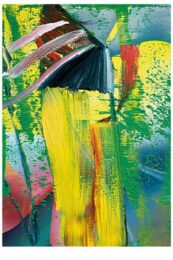

German artist Richter Gerhard is renowned for both abstract and realistic paintings, glasswork and photography. Alongside contemporaries such as Sigmar Polke and Georg Baselitz, he pioneered the movement known today as New European Painting. New European Painting was an artistic movement that expressed the sentiments in Europe after World War II, such as survival, memories, emotions and post-war life. Gerhard did not limit himself to a single style and cites Picasso and Jean Arp as influences in this regard.
Richter Gerhard strives to recreate real life in his paintings, and often works from black and white photography. He projects a photograph directly onto a canvas, so that he can trace the outline of the image precisely. He then completes the work using a palette of colours to replicate the photographic image. He is renowned for using a blurring technique in his paintings, which he says makes objects in his work equally important and unimportant. An in-demand and highly regarded artist to this day, his work “Abstraktes Bilt” sold at Sotheby’s auctioneers in London for over £21 million, a then word record figure for a sale by a living artist. Gerhard has since had a further two auction sales that have exceeded that amount.